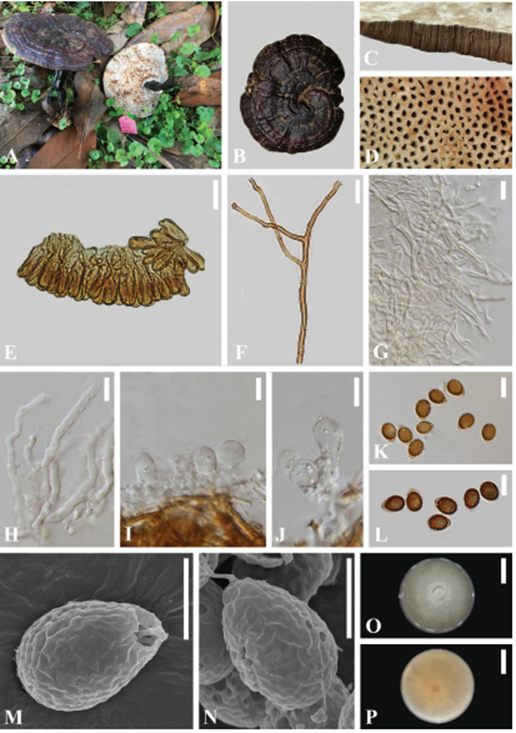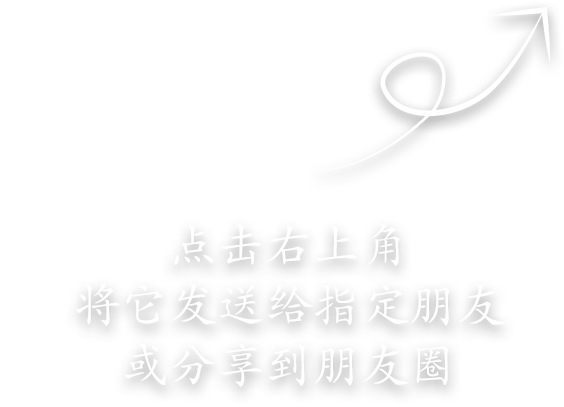 86
86
Ganoderma dianzhongense J. He, H.Y. Su & S.H. Li, sp. nov. 2021
Fungorum number: 558822
MycoBank No: 841408
Holotype. China. Yunnan Province, Kunming City, Luquan County, on the rotten broad-leaved trees, alt. 2480 m, Shu-Hong Li, 8 Sept. 2016, L4331 (HKAS 110005)
Morphological description :
Asexual morph: Basidiomata annual, stipitate, sub-mesopodal to mesopodal or with the back sides fused, coriaceous to woody. Pileus single, suborbicular to reniform, up to 4.8–13.1 cm diam., 1.1 cm thick, weakly to strongly laccate, glossy and shiny, oxblood red (9E7) to violet brown (11F8), smooth, and covered by a thin hard crust, concentrically zonate or azonate. Margin distinct, slightly obtuse. Stipe 9.0–17.7 × 1.1–1.9 cm, central, cylindrical, strongly laccate, dark red brown (11C8) to purplish (14A8) or almost blackish red-brown (10F4), fibrous to woody. Context up to 0.4 cm thick, duplex; lower layer dark brown (8F8), fibrous, composed of coarse loose fibrils; upper layer putty (4B2); corky to woody, bearing distinct concentric growth zones, without black melanoid band. Tubes woody hard, grayish brown, up to 0.9 cm long, unstratified. Pore 4–6 per mm, round to angular, dissepiments slightly thick, entire; pore surface grey white to lead gray (2D2), turning light buff when dust (5D1). Hyphal system trimitic. Generative hyphae 2.0–3.5 μm in diameter, colorless, thinwalled, clamp connections present; skeletal hyphae 3.0–6.0 μm in diameter, subthickwalled to solid, non-septate, arboriform with few branches, yellowish to golden-yellow; binding hyphae 1–2.5 μm in diameter, thick-walled, frequently branched, interwoven, hyaline to yellowish, scarce; all the hyphae IKI–, CB+; tissues darkening in KOH. Pileipellis a crustohymeniderm, cells 20–45 × 5.5–7.5 μm, clavate to cylindrical, entire or rarely with one lateral protuberance, thick-walled, without granulations in the apex, golden-yellow to yellowish-brown, thick-walled, moderately amyloid at maturity.
sexual morph : Basidiospores (80/6/3) (9.0) 10–11.0–12.0 (12.5) × (6.5) 7.0–7.9–8.5 (9.0) μm, Q = (1.12) 1.25–1.55 (1.63), Qm = 1.40±0.09 (including myxosporium); holotype: (40/2/1) 10.0–10.9–12 × 7.0–7.9–8.5 (9.0) μm,Q = (1.20) 1.25–1.52, Qm = 1.39±0.08 (including myxosporium). mostly melon seed-shaped at maturity to broadly ellipsoid, usually with one end tapering and obtuse at maturity, with apical germ pore, yellowish to medium brown, IKI–, CB+, inamyloid; perisporium wrinkled, double-walled, with coarse interwall pillars. Basidia widely clavate to utriform, hyaline, with a clamp connection and four sterigmata, 11–19 ×10–13µm; basidioles pear-shaped to fusiform, 10–15 × 8–12 µm.
Culture characteristics:
Habitat: Habit. Scattered, during fall, decaying wood of broad-leaved trees including Quercus sp. Currently, only known from central Yunnan province, China.
Distribution: China. Yunnan province, Shilin County, alt. 2109m, Jun He, 28 Aug., 2019,
GenBank: L4969 (HKAS 112719); Songming County, alt. 2204m, Shu-Hong Li, 8 Jul., 2016,L4230 (HKAS 112716); Wuding County, alt. 2295m, Shu-Hong Li, 24 Jul., 2019, L4737 (HKAS 112717); ibid, alt. 2432m, Jun He, 26 Jul., 2019, L4759 (HKAS 112718)
Notes:
Reference: [1] Pongkawong, U. , Kampuansai, J. , Pollawatn, R. , & Jampeetong, A. . (2021). Morphometry and phylogeny of the different populations of selaginella tamariscina (p. beauv.) spring and s. pulvinata (hook. & grev.) maxim. in northern thailand. Chiang Mai University Journal of Natural Sciences.
 Ganoderma dianzhongense (HKAS 110005, holotype) A basidiomata B upper surface C cut side of pileus D pore surface E sections of pileipellis (LM) F skeletal hyphae from context (LM) G binging hyphae from tubes (LM) H generative hyphae from tubes (LM) I-J basidia and basidioles (LM) K-L basidiospores (LM) M-N basidiospores (SEM) O-P culture after incubation at 28 °C for 8 days. Scale bars: 20 mm (O, P); 10 µm (E-L); 5 µm (M, N). Photographs Jun He
Ganoderma dianzhongense (HKAS 110005, holotype) A basidiomata B upper surface C cut side of pileus D pore surface E sections of pileipellis (LM) F skeletal hyphae from context (LM) G binging hyphae from tubes (LM) H generative hyphae from tubes (LM) I-J basidia and basidioles (LM) K-L basidiospores (LM) M-N basidiospores (SEM) O-P culture after incubation at 28 °C for 8 days. Scale bars: 20 mm (O, P); 10 µm (E-L); 5 µm (M, N). Photographs Jun He

